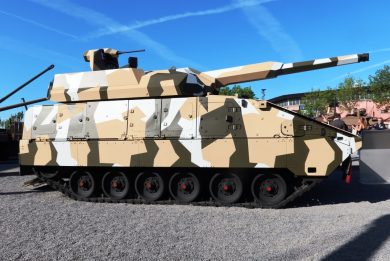KNDS unveils its new electronic programmable artillery fuzes
At the Future Artillery Conference organised in Paris by Defence iQ in late May, KNDS unveiled its new programmable artillery fuzes system, which is made of two programmable fuzes and a handheld lightweight inductive fuze setter
An artillery system is made of many components, a fire control system with ancillaries such as meteorological stations, the gun/howitzer eventually carried by a wheeled or tracked platform, the propelling charge, the round and the fuze. In the kill chain the latter is definitely the last one to intervene, allowing the artillery round to detonate at the right moment.
At the Future Artillery Conference KNDS, the French-German company that conglomerated two of the major land defence players of the two countries in a single entity, exhibited its new programmable artillery fuzes system, which is in a very advanced development phase by the Italian ammunition branch of the group, which is now named as KNDS Ammo Italy. The system is made of three components, the FB375MkII-IM multirole fuse, the FB374 fuse for cargo rounds, and the FB22 Inductive Fuse Setter.
All three products were designed in strictly accordance with NATO AOP-22[1]; this allows both fuzes to be programmed by third parties fuze setters, while the KNDS fuze setter is able to programme third party fuzes, as long as all respect AOP-22 standard. The three elements of the KNDS system will be added to the AOP-22 compliance document in the incoming release.
The first element of the system, the FB375Mk2-IM also known as FOX, reached qualification in late 2023. The fuze is electronic inductively programmable and can be used both on 105 mm and 155 mm artillery projectiles. A multifunction fuze, it can be set in four different modes, height of burst (HoB), point detonation super quick (PD SQ), point detonation delay (PD D) and time, allowing optimising the terminal effects of the round according to the type of target.
The HoB mode can be set with three different heights, which are pre-programmed at production level according to customers’ requirements. The fuze proximity is activated in the last 3 seconds of the round flight, to minimise any possible jamming by enemy electromagnetic sources. The PD SQ mode ensures detonation within 250 microseconds from impact. The PD D mode maximum delay is 60 milliseconds, which can be programmed in 1 millisecond steps. In the time mode, time can be set up to 199.9 seconds delay in 0.1 seconds steps. This delay time corresponds to the NATO standard AOP-22 which has been guiding the whole system development.
As said qualification was reached in 2023, the fuze being tested on several types of ammunition such as 105mm M1 and M107, LU107, LU211 155 mm rounds as well as other Extended Range and Base Bleed ammunition. The FOX was tested from PzH 2000 tracked self-propelled 155/52 mm howitzers but most of the tests were carried out from the Caesar 155/52 mm truck mounted artillery system produced by KNDS.
The FOX was also qualified in respect to insensitive munition (IM) standards. KNDS Ammo Italy is producing its own IM family of explosive in three different types, ES3, ES5 and ES9, these being used also in the production of missile warheads.
The FB375Mk2-IM respects the standards for standard HE rounds. For cargo munitions the element that intrudes into the round must be shorter, and not all modes used in the FOX are needed. Therefore, leveraging the work done on the FB375Mk2-IM, KNDS developed the FB374, which can also be used for illuminating and smoke ammunition, always in 105 and 155 mm calibres. This fuze maintains only two of the FOX modes, the time, and the PD SQ. They keep exactly the same parameters, the PD SQ being used only as a backup mode to the time mode in case of an impact before the set time.
Both the FB375Mk2-IM and the FB374 would be useless without a programming device. KNDS therefore developed the FB22 inductive hand-held fuze setter. At less than 1.5 kg, its case is made of aluminium making it rugged, and it can be used with a single hand through the rubber waterproof keypad. Data can be set manually through the keypad; however, the FB22 features an electric interface that allows the fuze setter to be linked to the fire control system, feeding automatically programming data into the fuze.
Battery powered, the FB22 has an 8-years or 10,000 programming cycles autonomy. As the FB374, the FB22 will be qualified by late 2024, the full KNDS system being therefore available to customers in 2025.
[1] Allied Ordnance Publication-22 or AOP-22: Design Criteria and Test Methods for Inductive Setting of Large Calibre Projectile Fuzes
Photos by P. Valpolini






